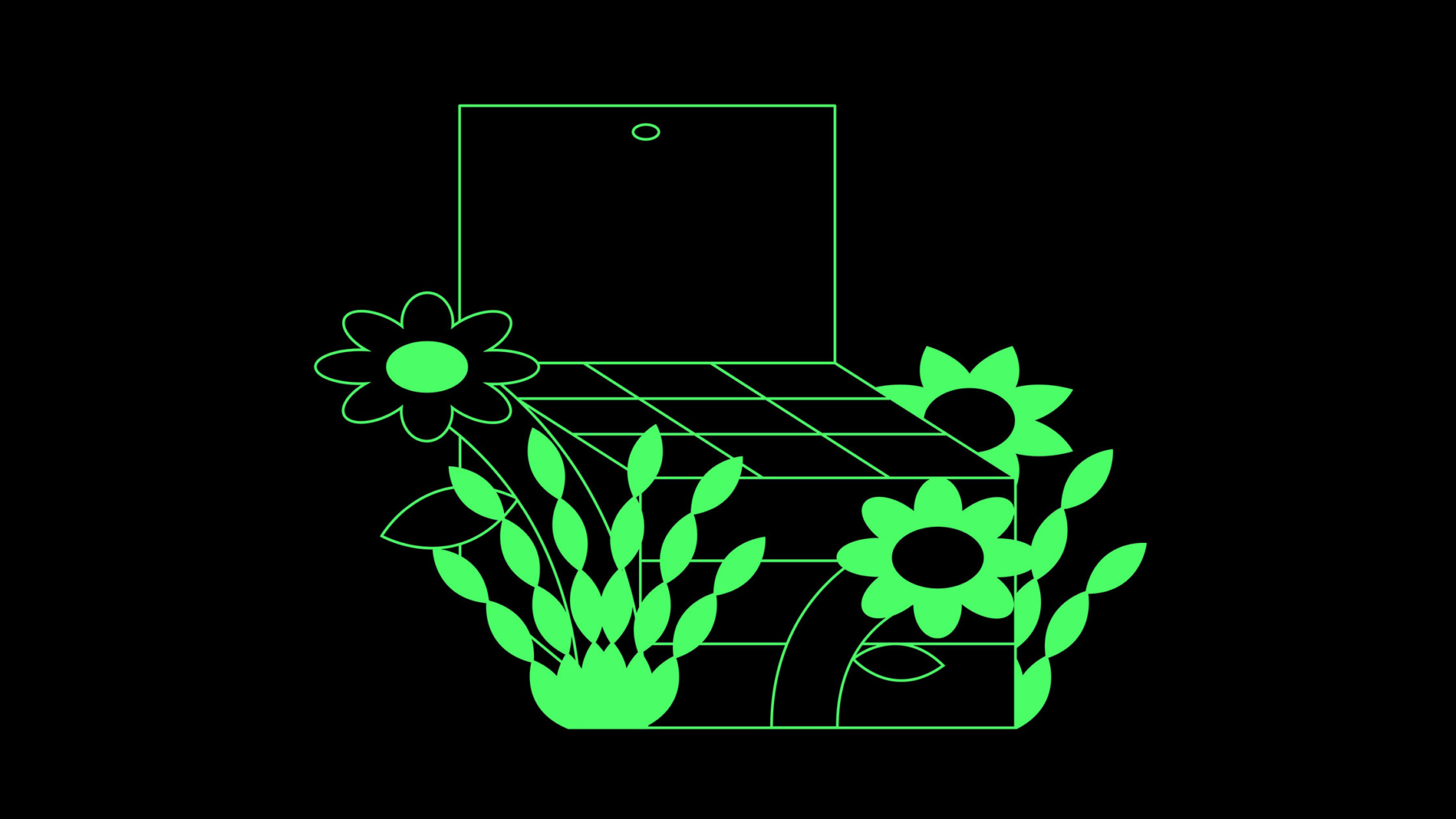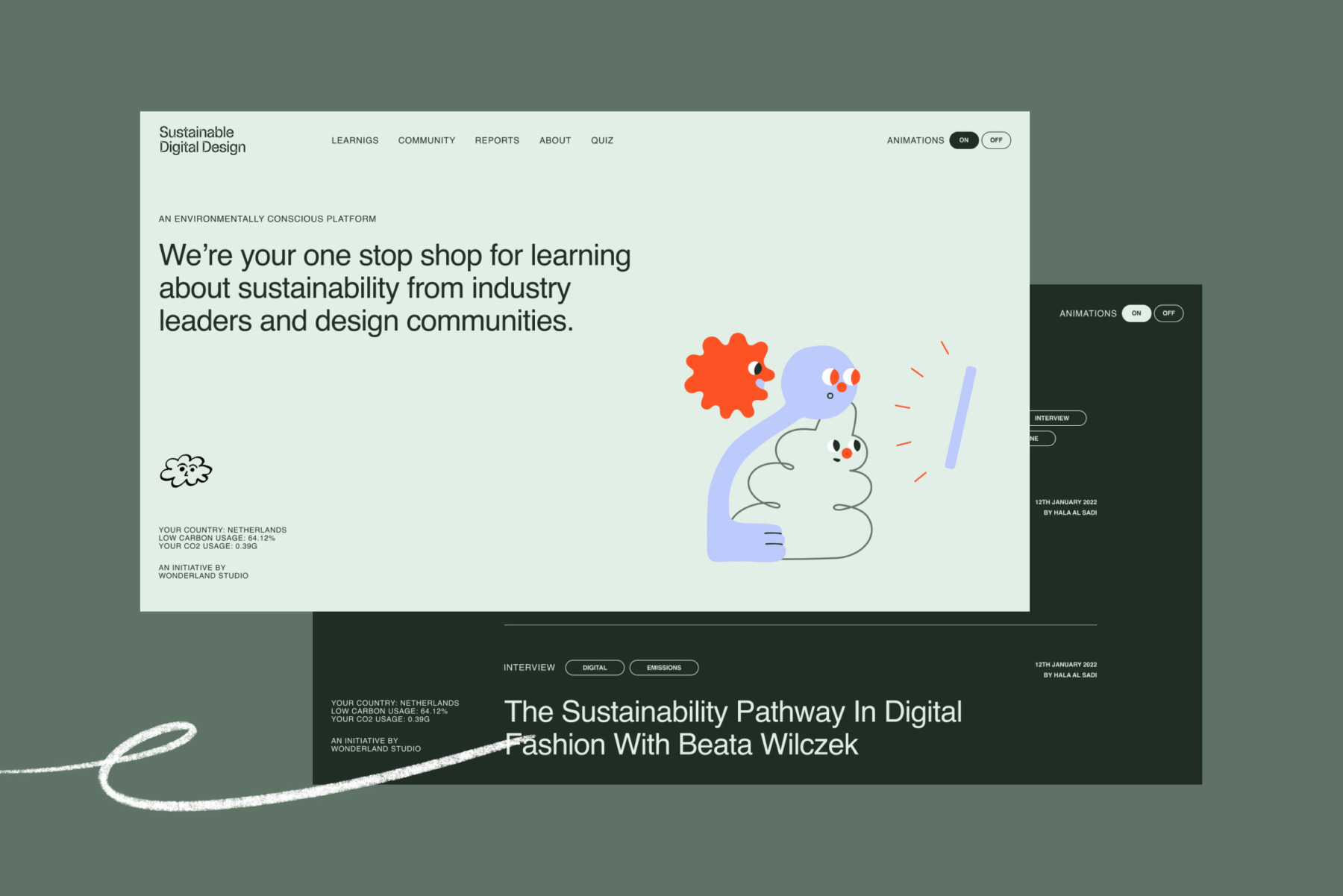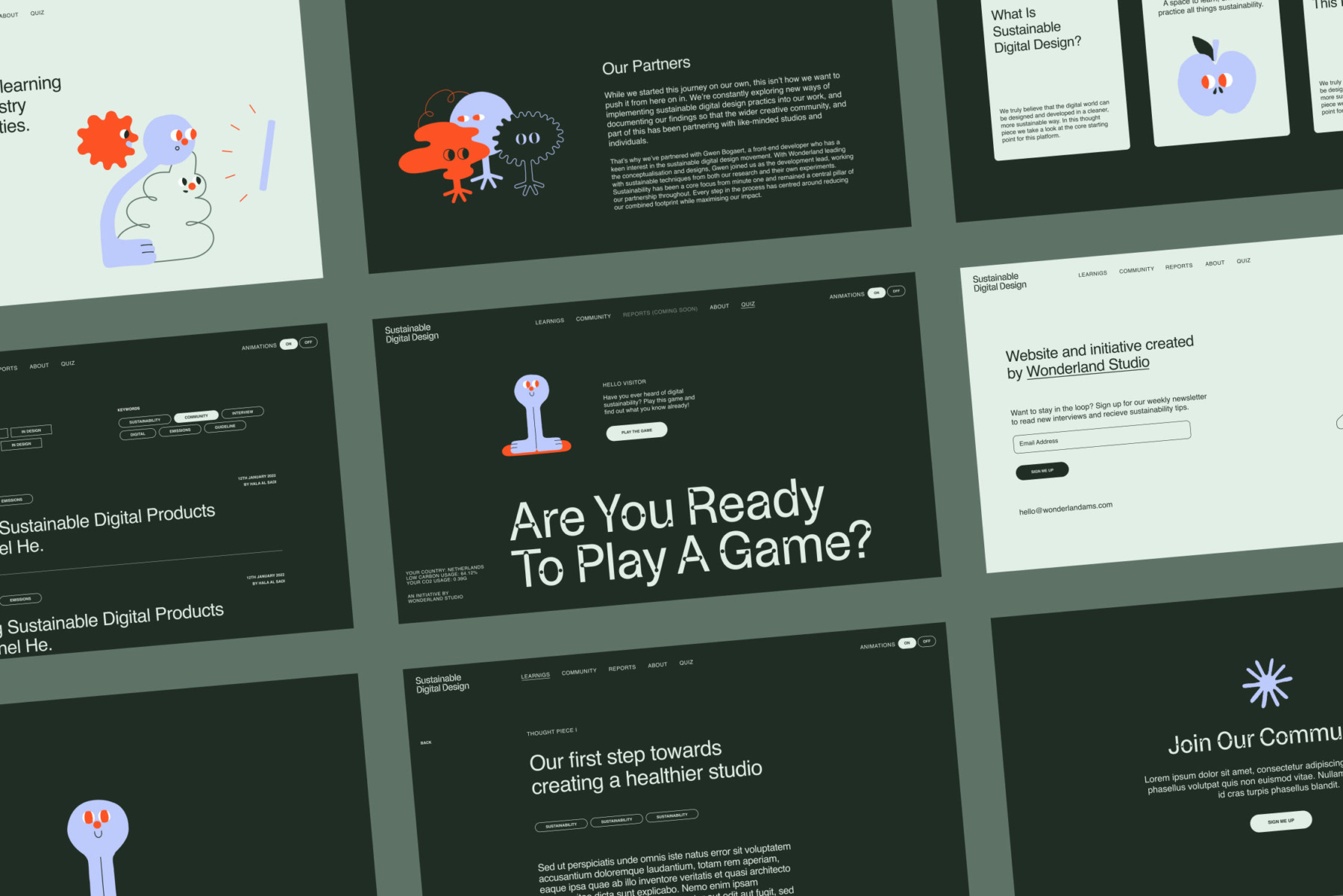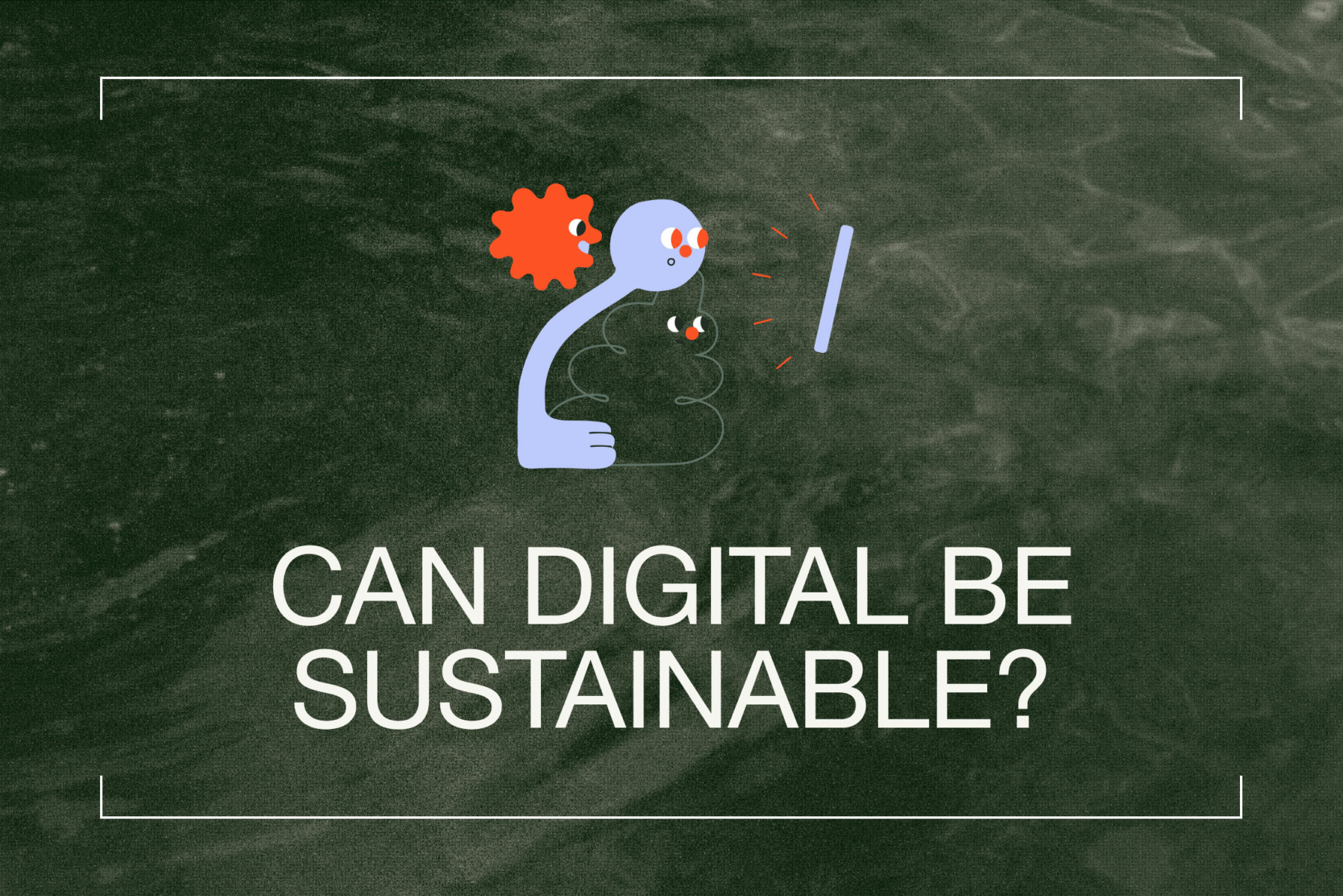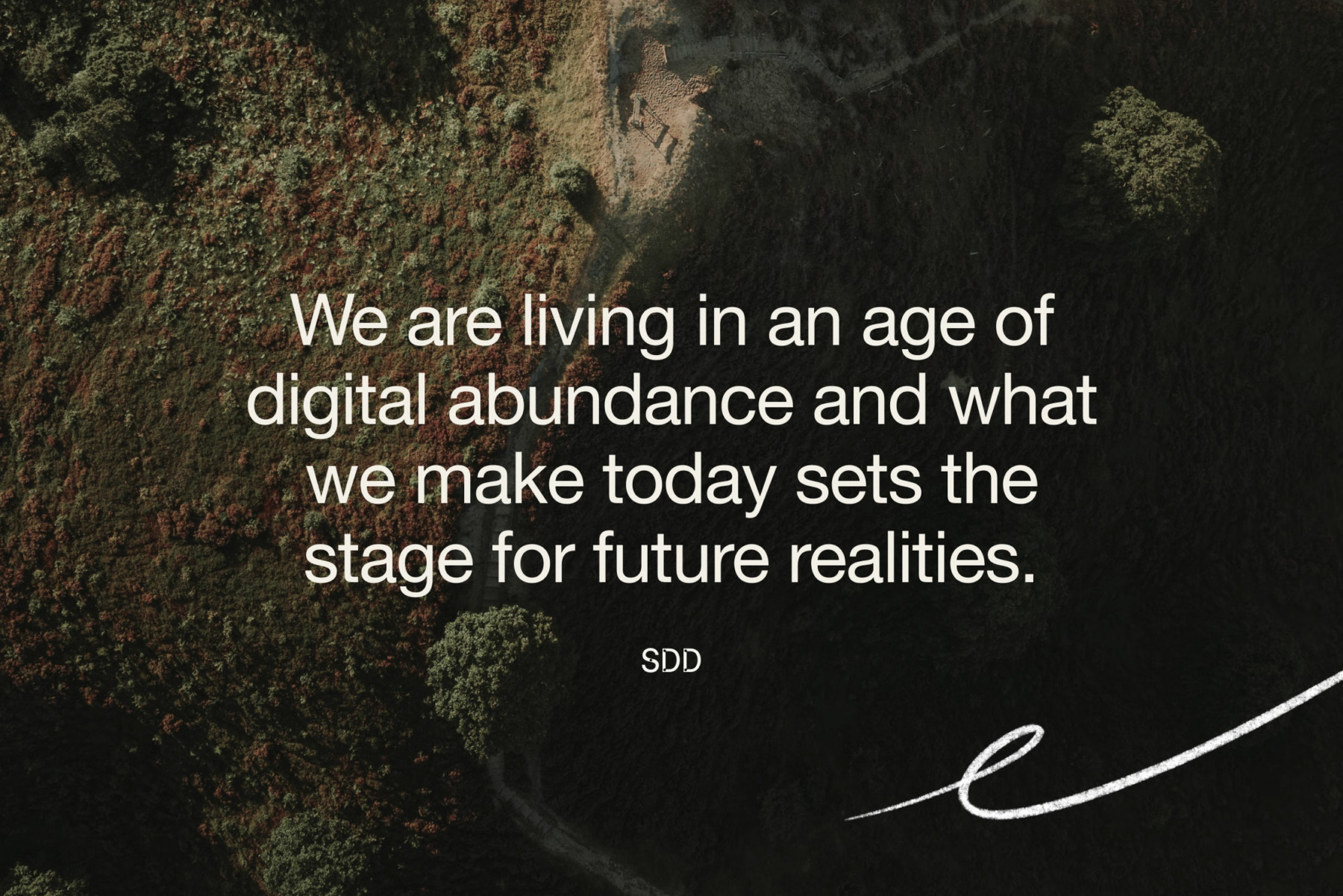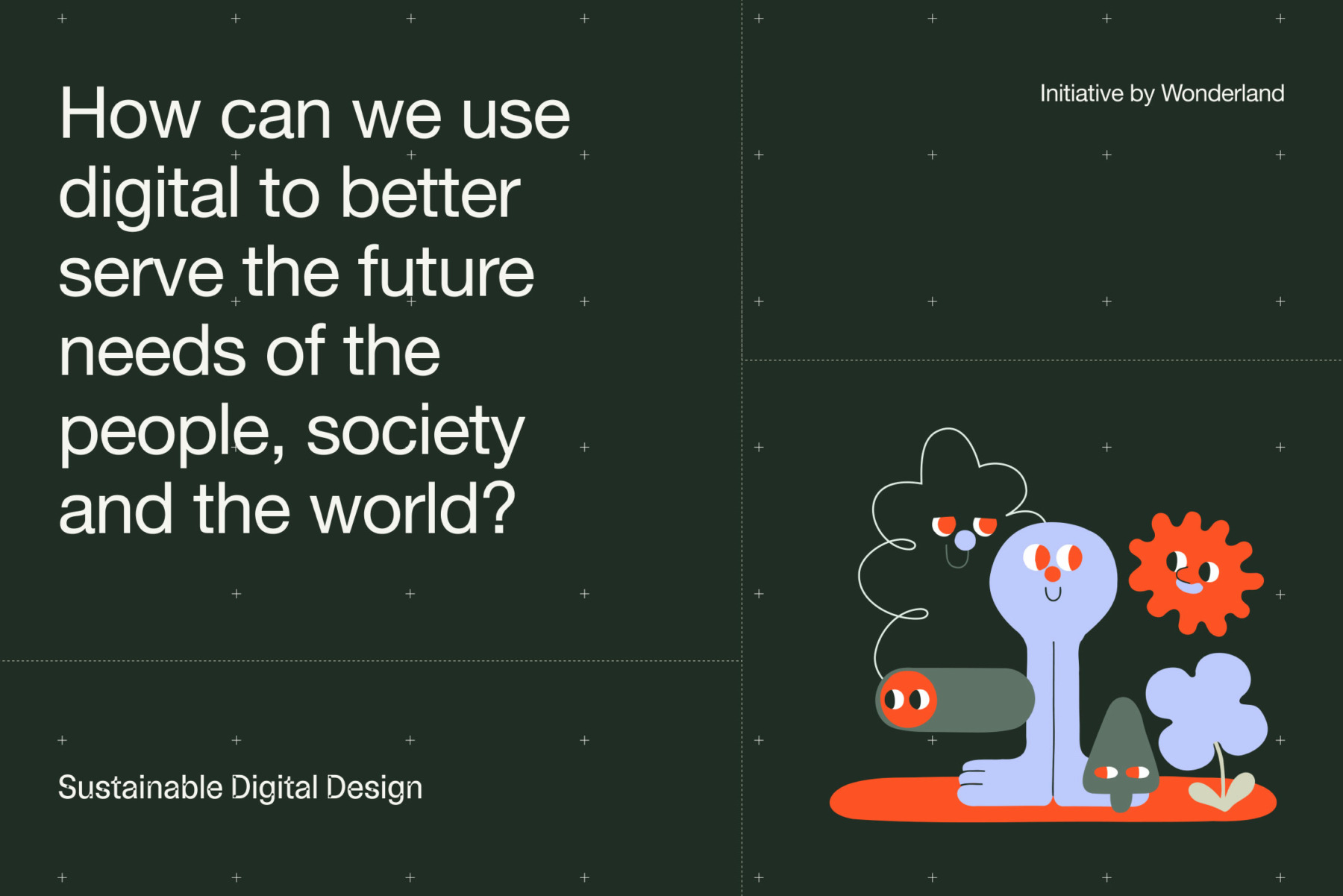Over the past decade, the work of writers, editors, and photographers, has come to rely on digital technologies to an unprecedented extent. From emails and cloud services to digital websites featuring dynamic layouts and immersive experiences, the internet has re-shaped creative work in a lot of exciting ways.
At the same time, the beauty and seemingly endless possibilities brought on by the web, paired with growing concerns over the social and environmental impact of material production, consumption, and accumulation (think printed matter and fast fashion) have perhaps overshadowed the environmental cost of digital and virtual services. Recent estimates show that digital technologies account for between 5 to 9% of global electricity consumption, a clear indication that the internet is far from being the insubstantial and ethereal space it is often imagined to be.
But how exactly does this relate back to our creative routines and processes? And how can digital publishing, along with other branches of the creative industry be rendered more sustainable? In the attempt to address these questions, broaden our views, and challenge our own creative practices—an interest we share with our design team at MoreSleep—we discovered a number of eye-opening projects spanning web design, digital design, publishing, and digital communication. We spoke to four of them about their insights and learnings.
Journalist Kris De Decker’s low-tech approach
According to Kris De Decker, the pathway to a more sustainable internet is “low-tech”. A journalist, researcher, and “low-tech advocate”, De Decker has been writing about the web’s energy use and how mechanical as well as analog devices might be of help since 2002. He is the founder of Low-Tech Magazine and No Tech Magazine, two pioneering publications exploring unconventional, somewhat nostalgic solutions to issues including the energy use of websites and of modern offices. Wanting to demonstrate that “the internet can be low-tech too,” in 2018 both publications were transferred to servers running on solar power with the help of designers Marie Otsuka and Lauren Traugott-Campbell. The current version is as beautiful as ever, but remember: it goes offline when it rains!
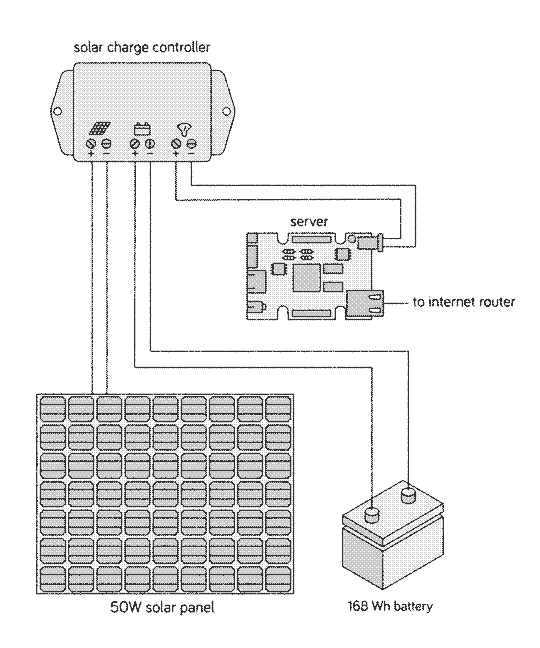
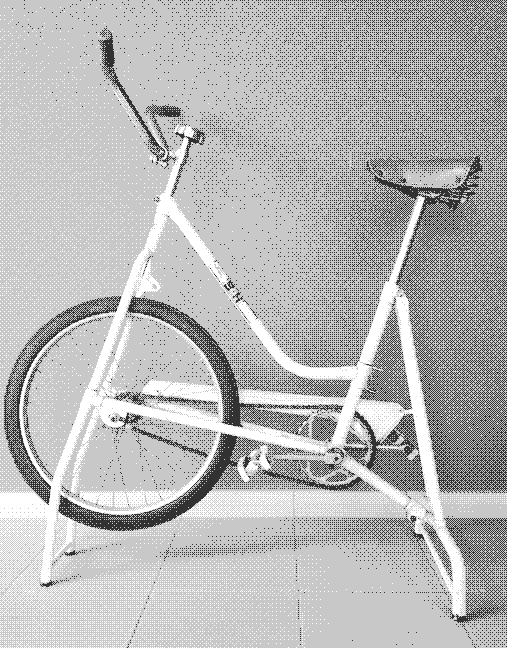
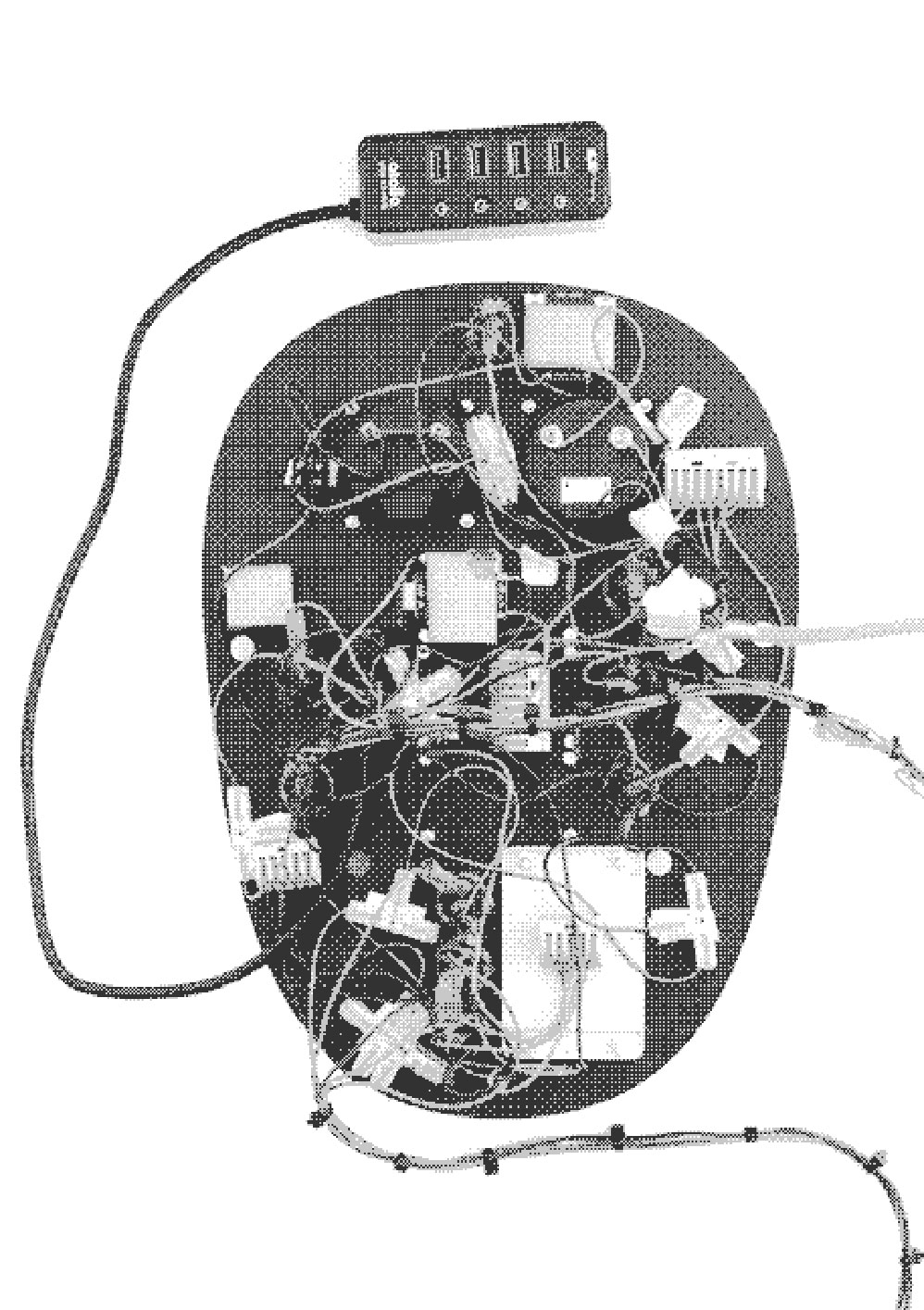
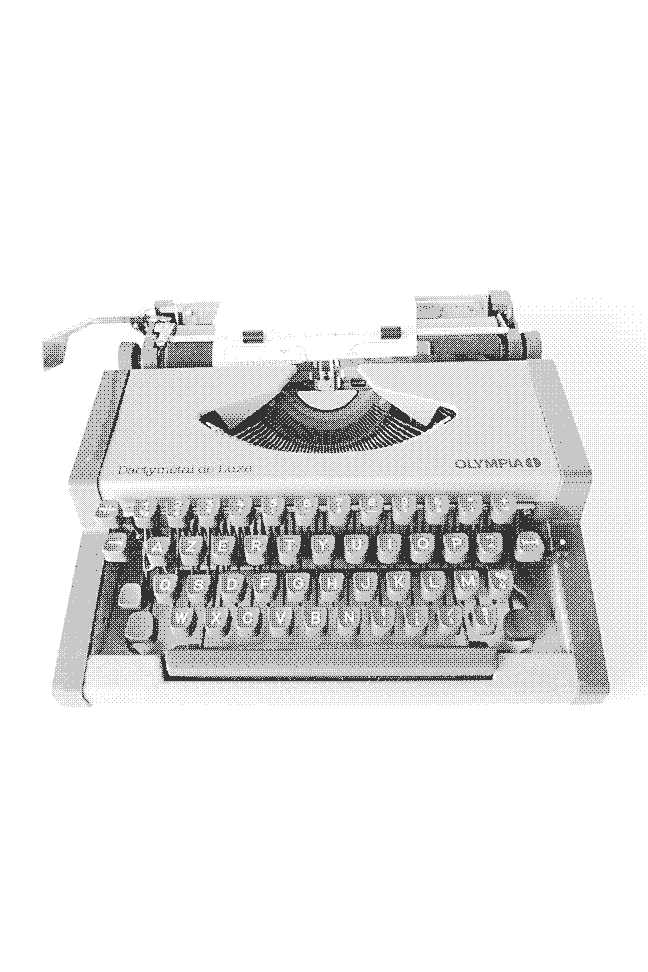
-
How did you first become aware of digital pollution?
As a journalist, I have been writing about the energy use of the internet for many years. From the beginning, the internet was presented as something that seems to defy the material world (everything is in the “clouds”), but I never bought that idea. Obviously, there is a massive infrastructure supporting our websites, and that infrastructure needs resources—energy and materials.
-
Based on your experience, what are three things that everyone working in media should know about the environmental impact of digital content:
(1) Our websites are getting “heavier” all the time, (2) we spend more and more time online, and (3) there is a lot of hidden data traffic (surveillance capitalism) that also pushes up energy use. These are the trends that are pushing up the energy use of the internet. Without addressing these, the problem won’t be solved.
Wonderland’s Sustainable Digital Design platform
Wonderland’s Sustainable Digital Design (SDD) platform is less critical of innovation and focuses more specifically on digital design—the design of digital assets, including graphics and websites—in the internet era. As Hala Alsadi, a project manager at the Amsterdam-based design studio explains, the project is a reflection of Wonderland’s own journey to increasing the sustainability of its practices. Reuniting perspectives from different creative fields, as well as the studio’s own research, the platform provides designers and curious passersby with entry-level concepts, industry reports, and handy guidelines for familiarizing with the topic.
-
How would you describe your work in connection with Sustainable Digital Design?
Our drive as a design studio is to ensure that our learnings from SDD are being applied to our work, and through this, we educate our clients on how to make their products and digital footprints more sustainable. Whilst still keeping the right balance of creativity and beauty in everything we produce, our goal is to achieve this in a more environmentally conscious manner.
-
Could you tell us about three things that everyone working in media should know about the environmental impact of digital content?
(1) Every link clicked, video streamed, or image downloaded leaves a mark on our planet. (2) There are different elements that contribute to how much energy a website can consume. These elements include choices of color, typography, animation, code size, and hosting servers. (3) When thinking about digital design more critically, you become aware that not every transition from physical to digital is ultimately sustainable. From here, you can embark on your own journey towards taking conscious steps to make your creative work have a positive impact.
Anyways Creative’s research into email clutter
Exploring yet another facet of our digital habits and their environmental cost is the London-based agency Anyways Creative. Their recent, self-initiated project Thanks in Advance unpacks the cost of people’s inboxes—did you know that, over a year, a single email inbox consumes enough energy to run a hot shower for about four min?—and encourages people to delete old emails. As Jeanne Harignordoquy, who worked closely on the project puts it, “the carbon cost of an email inbox is small, [but] it’s a nice entry point to explain how joint effort can make a real change.” In line with its ethos, the project’s findings and learnings were collected on a low-energy website that weighs as little as 36KB and is 97% greener than other sites, and translated into powerful visuals with the help of illustrator Jose Flores. The project, in other words, was also seen as an opportunity to apply their findings on people’s collective energy use to the design of a website.
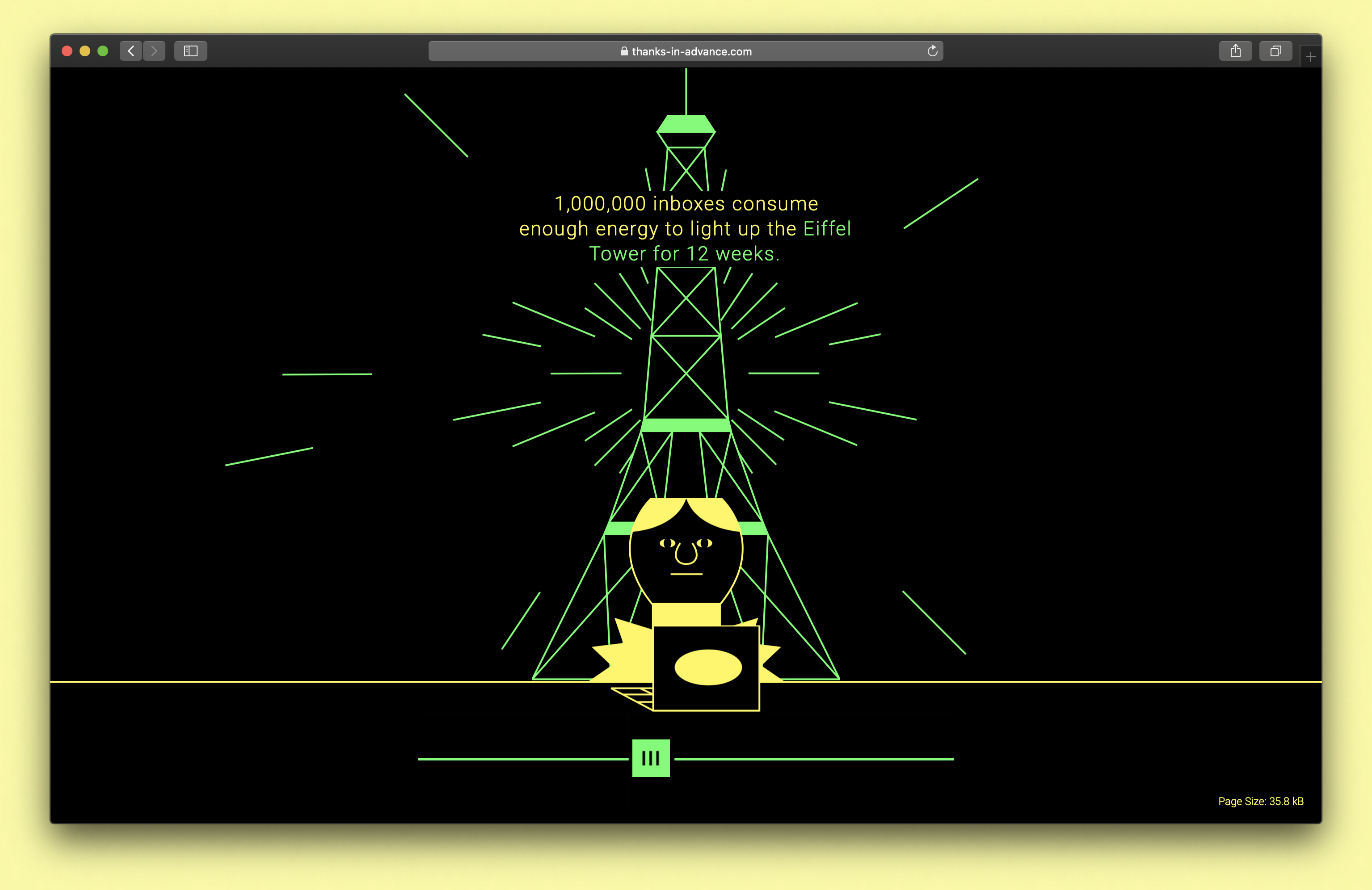
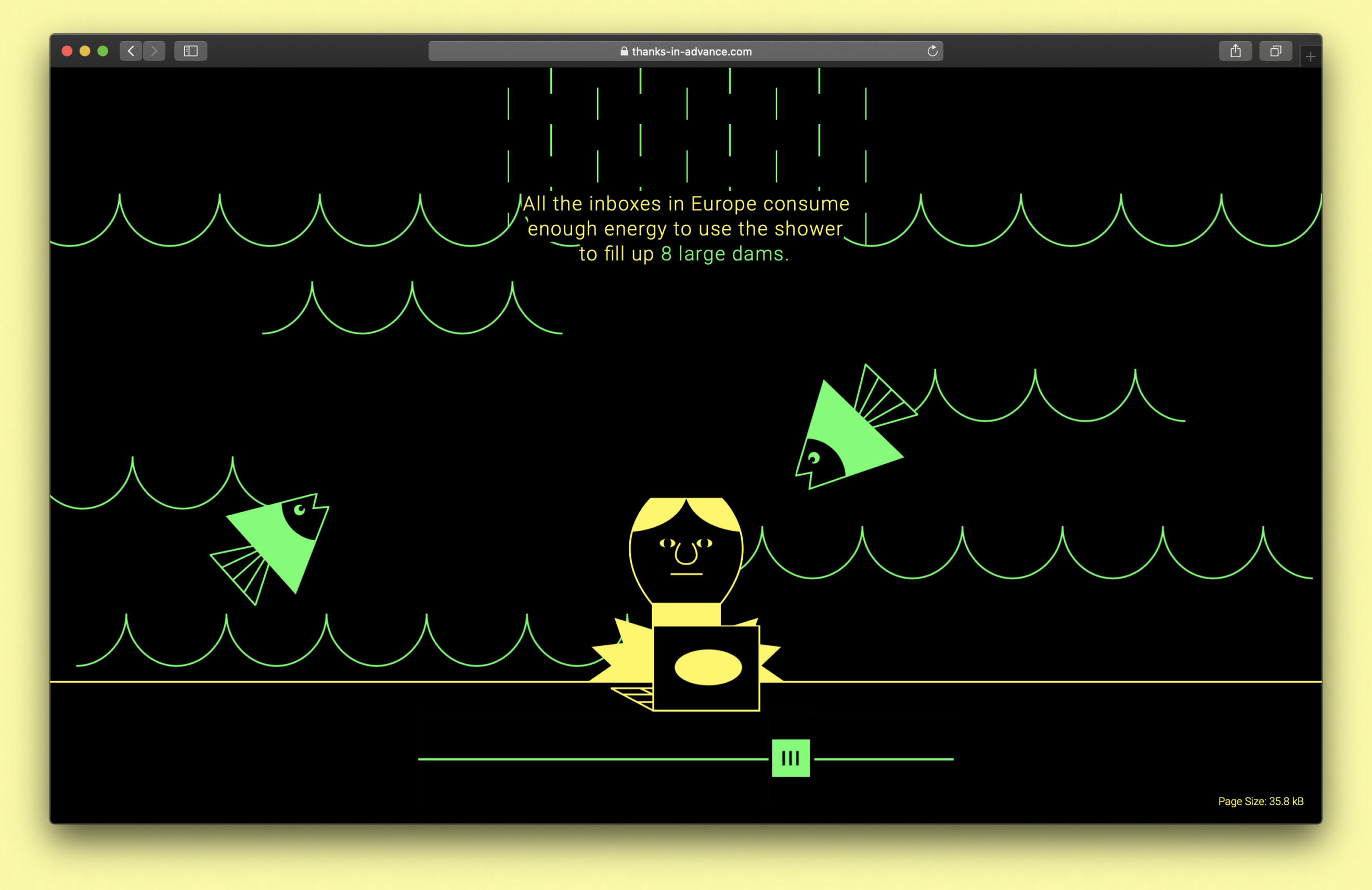
-
What inspired you to explore the environmental impact of emails and inboxes?
As a company that communicates a lot digitally, we felt that email was something quite tangible and an accessible route to consider in order to raise awareness about the wider topic of digital consumption. This is especially prevalent as the world continues to become ever more reliant on technology.
-
Could you tell us about three things that everyone working in media should know about the environmental impact of digital communication?
(1) Everything we do online is physically living somewhere on our planet and is energy hungry. And although technology is evolving and is becoming more and more efficient, the demand is multiplying, the construction of new data centers is booming, and waste is increasing. (2) BUT people should still be informed, inspired, and encouraged to search for better. The message here is not to stop making but to make better. In fact, the energy efficiency of what we do online can be improved with thoughtful design and habits. (3) Individual actions add up, and there is no project too small to start making a change.
Wholegrain Digital and Mightybyte’s Sustainable Web Design
Another great resource for learning about digital pollution and how to avoid it is Sustainable Web Design. Co-developed by London-based agencies Mightybytes and Wholegrain Digital, the site is particularly suited for web developers and designers looking to future-proof their practices.
Significantly, SWD’s approach relies on the Sustainable Web Manifesto, a set of principles—clean, efficient, open, honest, regenerative, and resilient—formulated by Wholegrain’s Managing Director, Tom Greenwood, in collaboration with a team of industry experts, and published in 2019 in an effort to encourage and guide the sector towards a more sustainable way of doing things.
-
How did you become aware of digital pollution and the need for more sustainable forms of web design?
When initially reviewing the B Impact assessment in preparation for becoming a B Corp, it became apparent that we could not provide any data about the environmental impact of the ‘products’ that we produce. This led to us asking whether there was any impact to digital services and triggered an internal research project from which we learned of the large energy consumption and carbon emissions of digital technology.
-
From your perspective, what should people working in media know about the environmental impact of websites?
(1) It’s bigger than you think. (2) Individual improvements—when multiplied by millions of pageviews—can make a big difference. (3) We already have most of the tools necessary to address the issue; we just need the collective knowledge and will to change.
For those wondering where to start, we collected our experts’ top tips below.
-
- 1 UPLOAD THE RIGHT IMAGE SIZE TO YOUR PLATFORM. “Large images are important and great at keeping your audience engaged and inspired but be smart about it. It will make the website faster to load and save a few hungry MegaBits.” — Jeanne Harignordoquy, Anyways Creative
- 2 AVOID ONLINE MAGAZINE VIEWERS. “PDF viewers are inefficient, slow, and have poor usability and accessibility. Delivering content as true web content rather than trying to put print documents online is a better approach in every sense.” — Tom Greenwood, Sustainable Web Design
- 3 IT’S BETTER TO HAVE VIDEOS HOSTED ON 3RD PARTY SITES. “Some of them have quite efficient ways to compress files without losing your resolution. And avoid Autoplay when not needed!”— Jeanne Harignordoquy, Anyways Creative
- 4 ASK YOUR DEVELOPMENT TEAM TO EVALUATE YOUR SITE. “Normally, websites are a build-up of code from Adhoc interactions—where the code can be optimized to reduce the number of requests. We made a 3 part guide series for how to make websites more sustainable, you can find these on the learnings section of our website” — Hala Alsadi, Sustainable Digital Design
- 5 CONSIDER BUILDING A STATIC WEBSITE. “A static website saves a lot of energy but it can also save you a lot of money for hosting your website.” — Kris De Decker, Low-tech Magazine
- 6 USE A GREEN HOSTING SERVICE. “It only uses renewable energy to power its servers and specializes in energy-efficient architecture. For Thanks in Advance, we used Kristal but there are lots of great other options available.” — Jeanne Harignordoquy, Anyways Creative
- 7 DELETE OLD FOLDERS. “On an organizational level, what about a digital spring clean sometimes? Encourage your team to delete old folders and calendar invite emails as a quick win.” — Jeanne Harignordoquy, Anyways Creative
- 8 MEASURE YOUR MAGAZINE’S IMPACT. “If you’re a company owner, use a free tool like the B Impact Assessment or similar to better understand your company’s social, environmental, and economic impact on stakeholders.” — Tim Frick, Sustainable Web Design
This Deep Dive explores the environmental impact of our digital habits and what can be done to reduce it in the context of media and publishing. If you’re interested in reading more about digital pollution in context of creative practice check out our Link List on building a more sustainable web.
Text: Amelie Varzi
Images: Diego Marmolejo, Jose Flores
